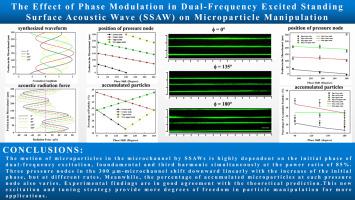Sensors and Actuators A: Physical ( IF 4.6 ) Pub Date : 2021-09-04 , DOI: 10.1016/j.sna.2021.113072 Yannapol Sriphutkiat , Yufeng Zhou

|
Standing surface acoustic wave (SSAW) in a microfluidic channel generated from a pair of interdigital transducers (IDTs) has already shown its capability of particle accumulation at the pressure node and its potential in biomedical research. Manipulation of cells or microparticles to the desired position precisely is an important issue of this technology. Using the phase modulation in the dual-frequency excitation, the fundamental and third harmonic of the same IDTs simultaneously with the initial phase difference between them and the power ratio of the fundamental wave to the third harmonic of 85%, the positions of three pressure nodes of the SSAW in the microchannel moves at different rates because of changes to the synthesized waveform and resultant acoustic radiation force. Meanwhile, percentages of microparticles at each pressure node also vary with the initial phase. Experimental measurement of green fluorescent microspheres in a diameter of 4 µm in a 300 µm-microchannel driven by SSAW at 6.2 and 17.7 MHz simultaneously has a good correlation with the numerical prediction (R2 = 0.967 and 0.89 for the position of each pressure node and the percentage of microspheres accumulated at each pressure node in the range of initial phase from 0° to 360°, respectively, where R is the correlation coefficient). This proposed method could provide more tunability for SSAW-based microparticle manipulation with few changes to the setup of lab-on-a-chip system.
中文翻译:

双频激发驻波表面声波 (SSAW) 中的相位调制对微粒操纵的影响
由一对叉指换能器 (IDT) 产生的微流体通道中的驻波表面声波 (SSAW) 已经显示出其在压力节点处积累颗粒的能力及其在生物医学研究中的潜力。将细胞或微粒精确地操纵到所需位置是该技术的一个重要问题。利用双频激励中的相位调制,相同IDT的基波和三次谐波同时具有初始相位差,基波与三次谐波的功率比为85%,三个压力节点的位置由于合成波形和合成声辐射力的变化,微通道中的 SSAW 以不同的速率移动。同时,每个压力节点的微粒百分比也随初始阶段而变化。在 300 µm 微通道中,由 SSAW 在 6.2 和 17.7 MHz 同时驱动的直径为 4 µm 的绿色荧光微球的实验测量与数值预测具有良好的相关性(R 2 = 0.967 和 0.89,分别表示每个压力节点的位置和在 0°到 360°的初始相位范围内每个压力节点积累的微球百分比,其中R是相关系数)。这种提出的方法可以为基于 SSAW 的微粒操作提供更多的可调性,而对芯片实验室系统的设置几乎没有变化。



























 京公网安备 11010802027423号
京公网安备 11010802027423号